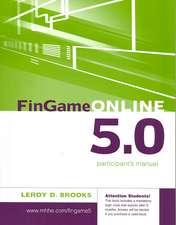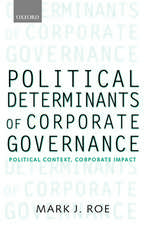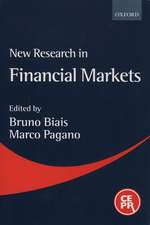Market Liquidity: Theory, Evidence, and Policy
Autor Thierry Foucault, Marco Pagano, Ailsa Roellen Limba Engleză Hardback – 4 apr 2013
Preț: 496.48 lei
Preț vechi: 547.27 lei
-9% Nou
Puncte Express: 745
Preț estimativ în valută:
95.02€ • 98.82$ • 79.51£
95.02€ • 98.82$ • 79.51£
Carte disponibilă
Livrare economică 10-17 februarie
Preluare comenzi: 021 569.72.76
Specificații
ISBN-13: 9780199936243
ISBN-10: 0199936242
Pagini: 448
Ilustrații: 58 b/w line
Dimensiuni: 242 x 162 x 27 mm
Greutate: 0.75 kg
Editura: Oxford University Press
Colecția OUP USA
Locul publicării:New York, United States
ISBN-10: 0199936242
Pagini: 448
Ilustrații: 58 b/w line
Dimensiuni: 242 x 162 x 27 mm
Greutate: 0.75 kg
Editura: Oxford University Press
Colecția OUP USA
Locul publicării:New York, United States
Recenzii
Market Liquidity by Professors Foucault, Pagano and Roell is a wonderful addition to the literature on how markets work; why, sometimes, they don't work as we might wish; and how this affects regulation and corporate decision making. The book is rich in detail, covering the institutional structure of financial markets and the economic and statistical models we use to understand them. While structured as a textbook, it can be read in different ways. Those less interested in the mathematical details will profit from the beautifully written description of the models, some of which are new, and their economic lessons.
Foucault, Pagano, and Röell need to be commended for writing this important and timely contribution on the topic of liquidity that has not just matured over the past twenty years, but which has in fact taken center stage as practitioners, policymakers, and academics use liquidity of markets as a barometer for the 'healthy functioning' of economies. The book is rigorous and precise, which is useful given liquidity has many connotations, and it delivers highly on all of its three parts: the first on notions of liquidity and its measurement; the second is on the role of policy and regulation in affecting market liquidity; and, the third on how market liquidity affects asset prices, financial crises, and corporate policies. I strongly recommend this book to all interested in understanding liquidity.
Drawing on their broad and extensive knowledge of market microstructure, three leading teachers and researchers have written a comprehensive guide to the principles and practicalities of securities trading. Market Liquidity comprehensively covers the dealer and limit order markets that account for the preponderance of trading volume. It provides perspectives on these markets from the viewpoints of market operators, traders, and regulators, and connects these markets to real corporate and investment decisions. The exposition is extremely systematic, lucid, and accessible. Students and practitioners alike will find this text to be current and invaluable.
This book is a highly readable introduction to market microstructure, emphasizing both practical institutional details and applications of theoretical and empirical research to the real world of trading. It is not only a useful introduction to market microstructure for practitioners, but also a great textbook for students at advanced undergraduate, masters, and even PhD levels. I like in particular the numerous connections the book makes between trading institutions and public policy issues.
Foucault, Pagano, and Röell need to be commended for writing this important and timely contribution on the topic of liquidity that has not just matured over the past twenty years, but which has in fact taken center stage as practitioners, policymakers, and academics use liquidity of markets as a barometer for the 'healthy functioning' of economies. The book is rigorous and precise, which is useful given liquidity has many connotations, and it delivers highly on all of its three parts: the first on notions of liquidity and its measurement; the second is on the role of policy and regulation in affecting market liquidity; and, the third on how market liquidity affects asset prices, financial crises, and corporate policies. I strongly recommend this book to all interested in understanding liquidity.
Drawing on their broad and extensive knowledge of market microstructure, three leading teachers and researchers have written a comprehensive guide to the principles and practicalities of securities trading. Market Liquidity comprehensively covers the dealer and limit order markets that account for the preponderance of trading volume. It provides perspectives on these markets from the viewpoints of market operators, traders, and regulators, and connects these markets to real corporate and investment decisions. The exposition is extremely systematic, lucid, and accessible. Students and practitioners alike will find this text to be current and invaluable.
This book is a highly readable introduction to market microstructure, emphasizing both practical institutional details and applications of theoretical and empirical research to the real world of trading. It is not only a useful introduction to market microstructure for practitioners, but also a great textbook for students at advanced undergraduate, masters, and even PhD levels. I like in particular the numerous connections the book makes between trading institutions and public policy issues.
Notă biografică
Thierry Foucault is Professor of Finance, HEC Paris International Business School.Marco Pagano is Professor of Economics, University of Naples Federico II.Ailsa Roëll is Professor of International and Public Affairs, Columbia University.













